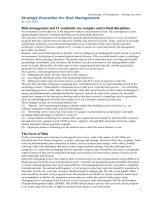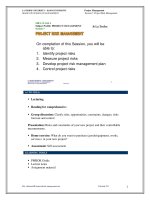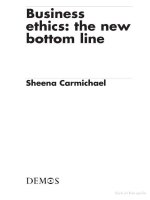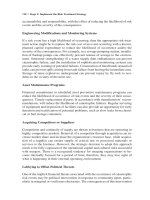Triple Bottom Line Risk Management Enhancing Profit Environmental Performance and Community Benefits_1 pptx
Bạn đang xem bản rút gọn của tài liệu. Xem và tải ngay bản đầy đủ của tài liệu tại đây (186.79 KB, 26 trang )
e
B O O K
W
ILEY
WILEY
JOSSEY-BASS
PFEIFFER
J.K.LASSER
CAPSTONE
WILEY-LISS
WILEY-VCH
WILEY-INTERSCIENCE
B u s i n e s s C u l i n a r y A r c h i t e c t u r e
C o m p u t e r G e n e r a l I n t e r e s t
C h i l d r e n L i f e S c i e n c e s B i o g r a p h y
A c c o u n t i n g F i n a n c e M a t h e m a t i c s
H i s t o r y S e l f - I m p r o v e m e n t H e a l t h
E n g i n e e r i n g G r a p h i c D e s i g n
A p p l i e d S c i e n c e s P s y c h o l o g y
I n t e r i o r D e s i g n B i o l o g y C h e m i s t r y
Triple Bottom Line
Risk Management
3672 P-00[FM] 5/3/01 2:08 PM Page i
3672 P-00[FM] 5/3/01 2:08 PM Page ii
Triple Bottom Line
Risk Management
Enhancing Profit,
Environmental Performance,
and Community Benefits
Adrian R. Bowden
Malcolm R. Lane
Julia H. Martin
John Wiley & Sons, Inc.
New York • Chichester • Weinheim • Brisbane • Singapore • Toronto
3672 P-00[FM] 5/3/01 2:08 PM Page iii
Copyright © 2001 by John Wiley & Sons, Inc. All rights reserved.
No part of this publication may be reproduced, stored in a retrieval system or
transmitted in any form or by any means, electronic, mechanical, photocopying,
recording, scanning or otherwise, except as permitted under Sections 107 or 108
of the 1976 United States Copyright Act, without either the prior written permis-
sion of the Publisher, or authorization through payment of the appropriate per-
copy fee to the Copyright Clearance Center, 222 Rosewood Drive, Danvers, MA
01923, (978) 750-8400, fax (978) 750-4744. Requests to the Publisher for per-
mission should be addressed to the Permissions Department, John Wiley & Sons,
Inc., 605 Third Avenue, New York, NY 10158-0012, (212) 850-6011, fax (212)
850-6008, E-Mail: PERMREQ @ WILEY.COM.
This publication is designed to provide accurate and authoritative information in
regard to the subject matter covered. It is sold with the understanding that the pub-
lisher is not engaged in rendering legal, accounting, or other professional ser-
vices. If legal advice or other expert assistance is required, the services of a
competent professional person should be sought.
This title is also available in print as ISBN 0-471-41557-X.
For more information about Wiley products, visit our web site at www.Wiley.com.
fcopyebk.qxd 6/1/01 10:40 AM Page 1
To the rest of the “Gang of Five”
3672 P-00[FM] 5/3/01 2:08 PM Page v
3672 P-00[FM] 5/3/01 2:08 PM Page vi
C
ONTENTS
Foreword xi
Acknowledgments xiii
Introduction xv
P
ART
O
NE
R
ISK
M
ANAGEMENT
1
1 Risk Management Process 3
Why Manage Risk? 5
What Are the Applications of Risk Management? 7
What Is the Risk Management Process? 8
Benefits of the Process 15
2 Why Use Anything Other Than Quantitative Risk Assessment? 17
Qualitative Risk Assessment 18
Semiquantitative Risk Assessment 20
Quantitative Risk Assessment 22
Quantifying “Nonquantifiable” Events 29
Benefits of Quantitative Risk Assessment 31
P
ART
T
WO
RISQUE M
ETHOD
33
3 Overview of the RISQUE Method 35
Role of Stakeholders 36
RISQUE Method Steps 38
4 Stage 1: Establish the Context 41
Tasks 41
Water Utility Example 45
5 Stage 2: Identify the Risk 47
Selection of an Expert Panel 47
The Panel Workshop 49
vii
3672 P-00[FM] 5/3/01 2:08 PM Page vii
Documentation of the Panel Conclusions 57
Water Utility Example 57
6 Stage 3: Analyze the Risk 65
Quantitative Modeling Techniques 65
Monte Carlo Simulation 66
Calculate Risk Quotient 72
Generate Risk Profiles and Maps 74
Calculate Risk Cost: Threshold Method 76
Calculate Risk Cost: Chance Method 80
Application of Risk Modeling Results 82
Water Utility Example 84
7 Stage 4: Formulate a Risk Treatment Strategy 93
Evaluate Risks against Performance Targets 95
Determine Risk Treatment Actions 96
Develop a Risk Treatment Strategy 97
Approve Strategy for Implementation 99
Water Utility Example 99
8 Stage 5: Implement the Risk Treatment Strategy 107
Risk Treatment Actions 107
Risk Sharing and Risk Transfer 107
Risk Reduction 109
Risk Acceptance 111
Implementation 113
Risk Management Systems 116
Summary 119
9 Benefits of the RISQUE Method 121
Risk Management and the RISQUE Method 121
Financial Accountability 122
Environmental Responsibility 125
Social Responsibility 126
P
ART
T
HREE
S
ELECTED
C
ASE
S
TUDIES
129
10 Project Selection: Mining, Papua New Guinea 137
Background 137
Mine Waste Management Project 139
Initial Risk Assessment (1996–1997) 141
First Review Risk Assessment (1999) 147
Second Review Risk Assessment (2000) 160
Summary 160
viii / Contents
3672 P-00[FM] 5/3/01 2:08 PM Page viii
11 Acquisitions: Power, United States 163
Background 163
Setting 164
Risk Identification 166
Risk Analysis 167
Bid Structure 171
Summary 175
12 Quantifying Intangibles: Land Development, Australia 177
Background 177
Setting 179
Risk Identification 182
Risk Analysis 188
Implementation: Cost Recovery and Responsibilities 190
Summary 192
13 Community Safety: Tourism, New Zealand 193
Background 193
Setting 194
Risk Identification 198
Risk Analysis 200
Summary 210
14 Financial Assurances: Waste Management, Australia 211
Background 211
Components of Landfill Financial Assurance 212
Risk Identification and Analysis 214
Analysis Results 214
Summary 221
15 Indemnity in Perpetuity: Mining, New Zealand 223
Background 223
Setting 226
Definition of “Perpetuity” 229
Risk Identification 230
Risk Analysis 239
Implementation and Risk Reduction 243
Summary 244
16 Corporate Reporting and Insurance: Resources Processing,
United States 245
Background 245
Risk Identification 248
Risk Analysis 251
Contents / ix
3672 P-00[FM] 5/3/01 2:08 PM Page ix
Strategy Development 256
Disclosure: SAB 92 262
Summary 265
17 Asset Management: Water, New Zealand 267
Background 267
Project Setting 268
Risk Identification and Quantification 275
Risk Analysis 282
Risk Reduction Strategies 284
Summary 291
Glossary 293
Index 303
x / Contents
3672 P-00[FM] 5/3/01 2:08 PM Page x
F
OREWORD
I would like to believe that this book is the result of a continuing process of inno-
vative improvement that we have been fostering in our firm for many years.
In 1991, I was the chief executive officer of Woodward-Clyde, an environ-
mental engineering consulting firm that is now part of the large, New York Stock
Exchange–listed, URS Corporation. At that time I was working closely with Steve
James, who had the global role to disseminate throughout our company innovative
technology developed by Woodward-Clyde. During a visit to Australia, Steve
was promoting a very comprehensive computer database called ERMIS (Envi-
ronmental Risk Management Information System). ERMIS had been developed in
Switzerland and the United States for a large French client in the automobile parts
manufacturing sector. When Steve arrived in Australia, he was asked to contact
Adrian Bowden in our Melbourne office, who would assess the potential of the
system and possibly could become responsible for introducing it to the Asia-
Pacific region.
Adrian accompanied Steve on one of his first presentations to a major client in
Melbourne. Steve gave a polished and comprehensive demonstration of ERMIS
that left the client representatives extremely impressed. The presentation showed
that through ERMIS the client could readily access large volumes of environ-
mental data (i.e., soil tests and groundwater analyses), link the data to compliance
requirements, and flag the required management actions. ERMIS introduced the
concept of environmental risk being the product of the probability of an environ-
mental event occurring by the cost of remediation. ERMIS also used a relatively
simple method to describe the uncertainty of remediation costs as probabilistic
cost distribution rather than single deterministic numbers.
After the presentation, Steve asked Adrian what he thought of the prospect of
providing ERMIS to the client. Adrian felt the model required too much data (at
the time comprehensive environmental data were usually not available for most
sites around the world), and even large corporations were not ready for ERMIS.
Maybe in ten years. Adrian believed, however, that many of his clients had a clear
need for a simpler tool that would use the same approach but that could be more
appropriately applied to sites with incomplete environmental information.
xi
3672 P-00[FM] 5/3/01 2:08 PM Page xi
The next day Steve and Adrian gave a modified presentation to a multinational
mining company. Steve concluded the presentation by making the point that the
ERMIS concept could be used in a much-simplified form to suit a wider range of
conditions. The corporate risk manager for the mining company was in the audi-
ence and was facing the immediate challenge of restructuring the company-wide,
third-party environmental insurance strategy in a cost-effective manner. The next
day the mining company engaged Woodward-Clyde to develop a prioritized
risk profile of third-party liability (both sudden and gradual) for all of its 36 sites
worldwide. This assignment was successfully completed in a short time using
available information and a relatively simple spreadsheet model. This project was
the first time that environmental risk profiles had been applied to obtain third-party
insurance.
Since that time Adrian and his colleagues have refined the method substan-
tially, and its capability has been greatly expanded to the point where it has been
shaped into a very useful approach to business risk management we refer to as
RISQUE method. This method forms the core of a totally new, very successful
business (Business Risk Strategies, a division of URS). The RISQUE method has
now been applied by the staff at Business Risk Strategies to a wide range of
applications. The method has been used to the immense benefit of a large number
of diverse clients around the world.
In recognition of their contributions to the development of innovative practice,
Woodward-Clyde/URS awarded both Steve James and Adrian Bowden the Yves
Lacroix Prize in 1992 and in 1996, respectively.
The story of the RISQUE method and Business Risk Strategies is a good ex-
ample of how an embryonic concept, when seeded in fertile ground and nurtured
in the right environment, can develop into a viable business in its own right.
Jean-Yves Perez
Executive Vice President and Director
URS Corporation
xii / Foreword
3672 P-00[FM] 5/3/01 2:08 PM Page xii
A
CKNOWLEDGMENTS
The authors are very appreciative of the unreserved support that URS Corporation
(formerly Woodward-Clyde) has given for initiation and development of the new
business that is the subject of this book. All of the projects described in the case
histories were performed by Business Risk Strategies (a division of URS). We are
fortunate that URS is committed to providing an environment that encourages new
ideas and ways of integrating them into the triple bottom line.
The case studies are published with kind permission of the following URS
client organizations: Ok Tedi Mining Limited; Water Corporation of Western
Australia; LandCorp; Eglinton Estates; Woodsome Management; Meridian En-
ergy Limited; Boral Recycling Pty Ltd.; Waihi Gold Company; and Metrowater.
The client organizations contributed immensely to each of the projects and
demonstrated a willingness to apply new technology and to venture into uncertain
territory.
Steve James was responsible for seeding the business initiative by introducing
the concept of quantifying difficult risk events and providing backup resources
during the early stages of business development. Steve, together with Jim Schaar-
smith, also contributed substantially to the discussion of corporate reporting and
SAB 92. Dale Cooper provided very constructive criticism that has added consid-
erable value to the RISQUE Method.
Many colleagues gave significant assistance with projects, marketing opportu-
nities or business development support. These people are: Martin Howell, Tom
Farrell, Jean-Yves Perez, Jim Miller, Simon Lee, Leanne Gough, Andrew Firth,
Harry Grynberg, Warren Pump, Jeff Smith, Stephen Hancock, Merv Jones, John
Gillett, Victoria Sedwick, Dan Predpall, and Alan Gale.
We acknowledge the time and experience given by the following individuals:
Bob Goodson, Steve Raab, Brian Fox-Lane, Tasio Cokis, Frank Kroll, Frank
Marra, Ross Yearsley, Bob Mackie, Willie Ng, Kathy Mason, Rob Fisher, Alison
Brown, Colin Stevens, Manapouri Power Station staff, Ken Voigt, Marshall Lee,
and the staff and advisers of OTML.
xiii
3672 P-00[FM] 5/3/01 2:08 PM Page xiii
3672 P-00[FM] 5/3/01 2:08 PM Page xiv
I
NTRODUCTION
Risk management increasingly appears as a key theme in conferences and litera-
ture targeted at a wide range of public and private sector businesses—no longer is
it the primary domain of the insurance industry. Surprisingly, the growing atten-
tion given to “risk” does not appear to be inspired by the profit-enhancing oppor-
tunities that risk management practices offer; rather it is driven by apprehension
associated with a negative perception of risk.
This negativity is reinforced by publicized cases of imprisonment of corporate
directors for regulatory compliance breaches, losses incurred by insurance under-
writers through coverage of environmental incidents, and an increasing incidence
of shareholder and broader community protests against perceived complacent and
arrogant corporate behavior. Unfortunately, this preoccupation with the adverse
consequences of risk events impedes recognition of the usefulness of risk man-
agement processes to optimize business practices and demonstrate corporate
responsiveness.
1
Businesses that want to be sustainable in the twenty-first century would be bet-
ter advised to adopt the philosophy that risk management is a process of continu-
ous improvement “directed towards the effective management of potential
opportunities and adverse effects”
2
(emphasis added). From an opportunistic
viewpoint, successful management of business risk has vast potential to improve
the so-called triple bottom line, the social, environmental, and financial account-
ability of a business.
3
For example, the Institute of Chartered Accountants
4
sug-
gests that well-executed risk management practices can potentially deliver the
following types of benefits to a company:
• A process for engagement of stakeholders and improving stakeholder relations
• Greater likelihood of achieving business objectives
• Increased likelihood of change initiatives being achieved
• More focus internally on developing and implementing best practice standards
• Lower cost of capital
• Better basis for strategic direction setting
xv
3672 P-00[FM] 5/3/01 2:08 PM Page xv
• Achievement of competitive advantage
• Reduction in management time spent “fire-fighting”
• Fewer sudden and unwelcome surprises
Our professional observations support that advice, and in this book we de-
scribe an approach that can be used to assess and quantify business risks in a way
that they can be addressed proactively in a company’s business management strat-
egy. The RISQUE method (risk identification and strategy using quantitative
evaluation) is a multifaceted approach that is designed to help business managers
make informed, defensible risk management decisions as part of a triple bottom
line management strategy.
We have developed the RISQUE method by listening to our clients’ needs and
trying to develop ways to apply our broad experience to a wide range of industrial
sectors and business management challenges. Our collective 60 years of consult-
ing experience in working with multidisciplinary teams has revealed that man-
agers responsible for making business decisions frequently have difficulty in
making the best use of the often complex, highly qualified, technical information
provided by their internal and external advisory experts.
The RISQUE method originated from an idea that Steve James, in his capacity
as a senior business strategist for Woodward-Clyde (now URS Corporation), in-
troduced in 1992. Since then we have applied the method (and its forerunner) to
many challenging new applications. These applications have included: water sup-
ply and wastewater asset management; quantification of the financial risk of ac-
quisitions; prioritizing management of environmental issues and development of
environmental risk management strategies; formulation of financial assurance
strategies for landfills and mines; estimation of mine rehabilitation costs; financial
benefit-cost analyses of mine tailings management options; economic analysis of
landfill postclosure management strategies; and financial reporting of contingent
liability.
A
IM OF
T
HIS
B
OOK
The aim of this book is to inform readers of current risk management approaches
and to demonstrate that a rational, quantitative method (the RISQUE method) is a
sound, defensible, transparent process that is very useful for development of risk
management strategies.
The RISQUE method is a risk management process that has been specifically
developed in response to the recognized need to translate complex, technical,
triple bottom line information into financial terms. It incorporates a quantitative
risk assessment process that translates the so-called intangible or nonquantifiable
environmental and social risks, such as community outcry, business reputation
damage, legal culpability, and environmental impacts, into financial measures that
xvi / Introduction
3672 P-00[FM] 5/3/01 2:08 PM Page xvi
can be used to develop risk treatment strategies. The broad application of the
RISQUE method is illustrated through a series of case studies.
By the end of this book, readers should:
• Appreciate the general concept of risk in relation to their business
• Understand the commonly used risk assessment techniques, together with their
advantages and disadvantages
• Have a basic understanding of the methodology, assumptions, advantages, and
disadvantages of the quantitative RISQUE method
• Have identified how the RISQUE method can be applied to specific areas
within their business to reduce negative risk and increase opportunities
• Know what specialist risk assessment skills to seek to assist development of
risk management strategies
• Feel equipped to implement a risk management process that will demonstrate
commitment to triple bottom line management
W
HO
S
HOULD
R
EAD
T
HIS
B
OOK
This book is intended for those professionals working in the private and public
business sectors who are:
• Making decisions based on complex factors, such as multiple sites or multi-
faceted events
• Responsible for ensuring that appropriate risk management processes are in
place to demonstrate due diligence
• In the process of acquiring or divesting capital assets
• Required to negotiate performance bonds and financial assurances with regu-
latory agencies
• Structuring corporate insurance strategies
• Selecting options that require financial analysis of benefit and cost
• Determining the value of a business and its contingent liabilities
Those who would find the book useful are:
• Business managers involved in strategic planning through to operations
• Policymakers
• Regulators
• Consultants
• Students of business management and applied technology
Introduction / xvii
3672 P-00[FM] 5/3/01 2:08 PM Page xvii
B
OOK
S
TRUCTURE
Part One outlines the need for risk management, describes the role of risk assess-
ment in the risk management process, and discusses current risk assessment ap-
proaches.
Chapter 1 (“Risk Management Process”) provides background information on
the nature of risk and discusses the risk management process and where risk as-
sessment, a fundamental component, fits into the process.
Chapter 2 (“Why Use Anything Other Than Quantitative Risk Assessment?”)
reviews the commonly used risk assessment practices (qualitative, semiquantita-
tive, and quantitative) and discusses their relative advantages and disadvantages.
Part Two (“RISQUE Method”) introduces the quantitative RISQUE method
and discusses development of risk treatment strategies.
Chapters 3 through 8 describe in detail the quantitative, five-stage RISQUE
method. These chapters describe (using examples) how the information derived
using this method can be arranged, related to common business indicators (e.g.,
net operating income, benefit-cost ratios, return on assets), and used to develop
strategies to manage and reduce business risk.
Chapter 9 (“Benefits of the RISQUE Method”) reminds us of the advantages
over other approaches and reiterates the benefits that application of the RISQUE
method can provide to business managers.
Part Three describes eight case studies where the RISQUE method has been
used, to demonstrate its applicability across a wide range of business activities and
events. The case studies should provide many pointers to enable readers to gener-
ate ideas where the RISQUE method might be applicable to their own business.
The introduction contains synopses for all case histories so that readers can
quickly assess which ones they would like to study in detail.
The case studies presented in Chapters 10 through 17 provide examples of sit-
uations where the following questions have been addressed:
• “Project Selection”: How can we select and justify the best option? (Ok Tedi,
Papua New Guinea, mine waste management options)
• “Acquisitions”: How much additional liability could we be acquiring? (Ac-
quisition of large power generation assets, United States)
• “Quantifying Intangibles”: How can we account for “nonquantifiable” events?
(Total community benefit cost analysis of land development opportunities at
Alkimos, Western Australia)
• “Community Safety”: How can personal injury be used as a measure of risk
and compared with accepted levels of societal risk? (Risk associated with a
tourism venture in Fiordland, New Zealand)
• “Financial Assurances”: What is a realistic financial assurance to place for
operation of a sanitary landfill? (Establishment of a financial assurance strategy
for a large municipal landfill, Australia)
xviii / Introduction
3672 P-00[FM] 5/3/01 2:08 PM Page xviii
• “Indemnity in Perpetuity”: How much do we need to set aside for future lia-
bilities? (Establishment of postclosure monetary bond for Waihi gold mine,
New Zealand)
• “Corporate Reporting and Insurance”: How can we comply with reporting re-
quirements, and what is the best insurance structure considering our risk pro-
file? (Mining and mineral processing plants, United States and Asia-Pacific
region)
• “Asset Management”: What asset management strategy gives us the best re-
turn? (Auckland, New Zealand, sewage pumping stations risk assessment)
At the end of the book, there is a glossary that defines the technical terms used
in the book.
We hope that this book will provide readers with ideas that they can use to im-
prove their business risk assessment processes and to formulate well-informed and
defensible risk management decisions that satisfy corporate objectives to increase
profit, improve environmental performance, and enhance community benefits: the
triple bottom line.
Notes
1. Corporate responsiveness describes the way in which companies address their corporate responsi-
bilities, that is, their legal, social, economic, and environmental obligations to the communities in
which they operate.
2. Standards Association of Australia, AS/NZS 4360: Risk Management. Strathfield, NSW: Standards
Association of Australia, April 12, 1999.
3. J. Elkington, Cannibals With Forks. The Triple Bottom Line of 21st Century Business. Oxford:
Capstone Publishing Limited, 1999.
4. Cited by M. Vincent, “Creating the Pathway for Corporate Change. Executive Briefing,” Corpo-
rate Risk, September 2000, p. 33.
Introduction / xix
3672 P-00[FM] 5/3/01 2:08 PM Page xix
3672 P-00[FM] 5/3/01 2:08 PM Page xx
Part One
R
ISK
M
ANAGEMENT
3672 P-01 5/3/01 2:10 PM Page 1
3672 P-01 5/3/01 2:10 PM Page 2
1
R
ISK
M
ANAGEMENT
P
ROCESS
Business risk is a condition involving exposure to events that would have an ad-
verse impact on a company’s objectives. Business risk is therefore a combination
of the likelihood of an event occurring and the magnitude of its consequences.
The term “business risk” covers the full range of risks faced by today’s com-
panies that have potential to affect the triple bottom line. A company’s business
risk portfolio may include events with potential for impacts on the organization’s
investments, income, staff and local community welfare, occupational health and
safety, the natural environment, company reputation, technological capability, se-
curity, political environment, property, and legal liabilities.
The scope of business risks is broad—risks may arise from a range of sources,
as demonstrated by the following five examples.
1
Depending on the activities in
which a business is involved, the number of risks may be reduced or expanded.
1. Strategic risk is the risk of planning failure. Strategic risks may include:
• Poor marketing strategy
• Poor acquisition strategy
• Unexpected changes in consumer behavior
• Political and regulatory change
2. Financial risk is the risk of failure of financial control. Financial risks may
arise from:
• Treasury operations
• Lack of counterparty and credit assessment
• Fraud and its control
• Systemic failure
• Poor receivables and inventory management
3. Operational risk is the risk of human actions, either willful or by omission.
Examples include:
• System mistakes
• Unsafe practices
3
3672 P-01 5/3/01 2:10 PM Page 3
• Employee routines
• Willful destruction
4. Commercial risk is the risk of business interruption. Commercial risks may
arise from:
• Loss of key personnel
• Supplier failure
• Legal issues and compliance
5. Technical risk is the risk of failure of physical assets. Examples include:
• Equipment failure
• Infrastructure breakdown
• Fire and physical impact
• Explosion and/or sabotage
• Pollution
• Natural events
Business risks arise from the occurrence of risk events—those events that
might reasonably be considered to have the potential to occur over the lifetime of
a business. For example, a large storage tank fire, in a well-operated fuel tank
farm (with a 50-year design life), would not be expected to occur over a 30-year
period, if safety measures have been implemented to decrease both the likelihood
of a fire and the magnitude of the consequences. Nevertheless, there remains a
very low likelihood that a large fire actually will occur within that time frame,
and therefore this eventuality should be considered as a risk event worthy of
assessment.
For the purposes of risk quantification, the magnitude of the risk is calculated
as the mathematical product of the likelihood of the risk event occurring and the
consequences. A risk event may pose a high risk because it is likely to occur fre-
quently, although the consequences may not be substantial in financial terms. A
risk event also may pose a high risk if it has a low likelihood of occurrence but the
consequences will be substantial in financial terms. A risk event that poses an “ex-
treme” risk to the business will represent both a high likelihood of occurrence and
substantial financial consequences.
It is important to recognize from the outset that identification and characteri-
zation of risks is an inherently subjective process that may be highly influenced by
the personal beliefs, training, and experience of the individuals who make judg-
ments about the risks.
For example, the risks posed by the presence of a large water storage dam are
likely to be perceived quite differently by a civil engineer as compared with a crop
farmer living downstream of the dam. Similarly, the operational risks posed by a
gold mine are likely to be perceived differently by the company’s corporate fi-
nancial controller compared with the company’s on-site environmental manager.
4 / Risk Management Process
3672 P-01 5/3/01 2:10 PM Page 4









